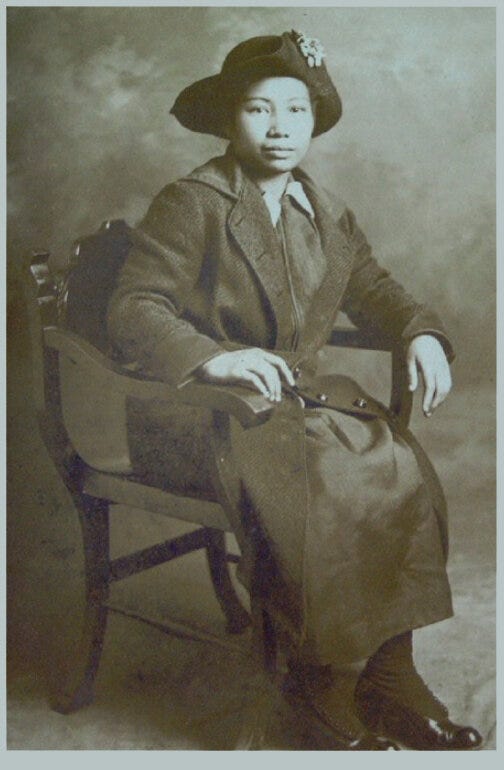The Story of María Ylagan Orosa
Pioneering Chemist, Food Technologist, Home Economist, Nutritionist, Rural Agricultural Programs Organizer, and WWII Resistance Leader (1893-1945)
Once upon a time, there was a girl named María Ylagan Orosa. María grew up on the Philippine Island of Luzon with seven brothers and sisters, and when she was young, the Philippine-American War raged around her. So did terrible hardship, in which far too many Filipinos died from disease and starvation. María's Dad was a steamship captain who served the resistance movement by secretly transporting troops and supplies. Soon after fleeing their home to escape American forces, her father was taken a political prisoner, and soon after, he died.
As a girl, María helped her mother support their family through a general store. As a young woman, she attended universities in the Philippines and the state of Washington, working summers in salmon canneries in Ketchikan, Alaska, where she learned industrial methods of food preservation and packaging. Despite significant racial and gender barriers, María earned bachelors and masters degrees in chemistry and pharmaceutical science, worked briefly as an assistant chemist for the State of Washington, and returned home…
Back in the Philippines, María worked as a university instructor teaching home economics, and as a chemist. She also served her government’s Bureau of Food Science, becoming head of the Home Economics division; chief of its Division of Food Preservation; and later, head of the plant utilization division of the Bureau of Plant Industry.
María created new ways of using and preserving indigenous foods, seeking to free her native land and people through food production independence from expensive imports and foreign control. All told, María created almost 700 innovative food products from native plants, among them, banana ketchup, still extremely popular among Filipinos around the world today; Soyalac, a nutrient-rich drink made from soybeans; and Darak, rice cookies packed with Vitamin B1, which could prevent beriberi disease. She innovated the practice of freezing and canning mangoes so they could be exported around the world. Also, she invented the Payalok Oven, which enabled Filipinos to bake foods like cakes from nutritious local flours, and over a fire, when electricity was unavailable.
María also traveled the world to learn methods of food technology and preservation as a government-sponsored scholar, and then returned to the Philippines, to teach, demonstrate, and promote these methods at home. She founded the Homemakers Association of the Philippines, deploying hundreds of demonstrators across the Philippines in a mission to educate women with limited resources in food preparation, gardening, poultry raising, and handicrafts, and different ways of earning income. Also, she founded the Health-Heart-Head-Hand (4-H) Club, dedicated to improving rural communities by seeking to engage youth through agriculturally focused, experiential learning programs to foster development in leadership and life skills. In 1924, the club had 22,000 members and exists today.
And then, one day, came the next war: WW II. After the Japanese bombed Pearl Harbor, and then attacked the Philippines, María’s family evacuated. However, María stayed…
María stayed to work in her lab and, under Japanese occupation, manage a food production operation with 400 of her students. As the conflict cut off imports and disrupted agricultural production, food shortages grew widespread. To supplement Filipinos’ meager wartime rations, María redirected her division’s resources into churning out nutrient-dense food products for those who remained, caught in the crossfire and wartime internment: to live; to fight; to work; to strive; to survive.
One of her relatives, alive in 2020, Evelyn Garcia, said, “To this day, we actually meet relatives that say ‘My grandfather survived the war because of Maria Y. Orosa.’”
In sum, María, always a fighter, an innovator, a humanitarian, a dreamer, and a nourisher of human stomachs, aspirations, and dreams, became part of the resistance.
During WW II, María became a captain in the Markings Guerrillas, a group that helped U.S. forces fight the occupying Japanese army. With her civilian army of students, María produced rations of Soyalac and Durak to feed themselves, hundreds of underground Filipino units, and thousands prisoners of war in places such as the Santo Tomas Internment Camp to whom she, and other members of the resistance, smuggled food.
María died a resistance leader and patriot, serving her country. She was hit by shrapnel while working in her lab, and died ten days later in the hospital, when a second shelling killed her and four hundred doctors and civilians.
While María posthumously received several honors, a surprise greeted archaeologists from the University of Philippines in February 2020 when they found, while excavating a tomb behind the former hospital in which she died, a stone engraved, “MARIA Y. OROSA / NOV. 29 1892 – FEB. 13 1945 / DIED IN LINE OF DUTY.”



Amazing story. Thank you.
Main Sources for this Story (Continued):
6) She Invented Banana Ketchup & Saved Thousands of Lives. Why Have We Never Heard of Her? The legendary story of María Orosa, the Philippines' greatest war hero., 3/16/2022, Food52, https://food52.com/blog/24700-maria-orosa-profile
7) Giants in History: María Orosa, Fighting for her country against hunger
María Orosa (29 November 1892 - 13 February 1945), Asia Research News, https://www.asiaresearchnews.com/content/mar%C3%ADa-orosa
8) How Philippine Food Scientist María Orosa Saved Thousands of POWs During World War II, Coffee or Die, 2/1/2022, https://coffeeordie.com/maria-orosa
9) Forgotten Foremothers: María Orosa, League of Women Voters of Muncie-Delaware County, 4/23/2021, https://www.lwvmunciedelaware.org/content.aspx?page_id=5&club_id=468470&item_id=63731
10) Maria Ylagan Orosa video by Mye Atienza on the "All About Maria Y. Orosa" webpage (http://www.orosa.org/Maria%20Y.%20Orosa%20Links.htm) of the Orosa family website at www.orosa.gov, produced by the Provincial Tourism & Cultural Affairs Office, Republic of the Philippines, https://www.pangasinan.gov.ph/department/provincial-tourism-and-cultural-affairs-office/.